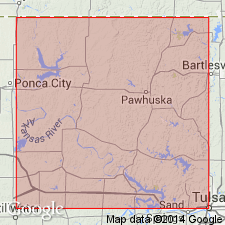
- Usage in publication:
-
- Cheshewalla sandstone
- Modifications:
-
- Original reference
- Dominant lithology:
-
- Sandstone
- AAPG geologic province:
-
- Chautauqua platform
Summary:
Pg. 60-61, pl. X. Cheshewalla sandstone; [Cheshewalla sandstone member of Nelagoney formation adopted by the USGS (ca. 1938)]. The first heavy bed of massive sandstone below Labadie limestone in T. 25 N., R. 10 E., [Osage Indian Reservation], Osage County, central northern Oklahoma. Thickness 20 to 50 feet. Is separated from the Labadie by 60+/- feet of shale and thin hard sandstones, with, in a few localities, a very thin limestone a few feet above the soft Cheshewalla. The Cheshewalla is fine-grained, moderately well cemented, rather soft, and cross-bedded. Few fossils. Along most of its outcrop in this township it appears as a single heavy bed without interbedded shale, but locally it contains lentils of red shale a mile or less long which cause the formation of benches. It lies 60 or 70 feet above Revard sandstone. Is well developed near point where Cheshewalla Creek empties into Nelagoney Creek, in SE/4 sec. 9, [southwest of Kiheki dome; see pl. X]. Age is Pennsylvanian.
[Typographical error: US geologic names lexicon, USGS Bull. 1200, p. 753, states exposures are in SE/4 sec. 10.]
Source: US geologic names lexicon (USGS Bull. 896, p. 420).
For more information, please contact Nancy Stamm, Geologic Names Committee Secretary.
Asterisk (*) indicates published by U.S. Geological Survey authors.
"No current usage" (†) implies that a name has been abandoned or has fallen into disuse. Former usage and, if known, replacement name given in parentheses ( ).
Slash (/) indicates name conflicts with nomenclatural guidelines (CSN, 1933; ACSN, 1961, 1970; NACSN, 1983, 2005, 2021). May be explained within brackets ([ ]).

